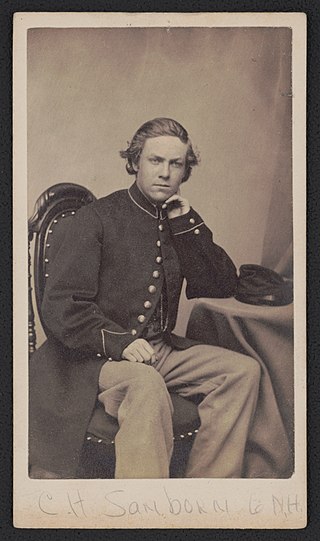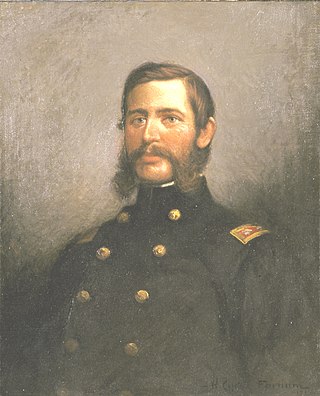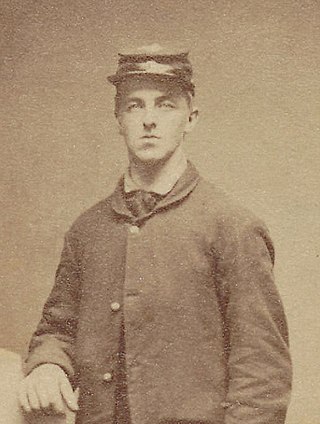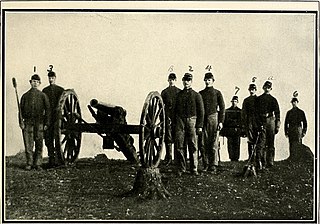
Sumner Carruth was an officer in the volunteer army of the United States during the American Civil War. He commanded the 35th Massachusetts Volunteer Infantry and eventually rose to the command of two different brigades in the IX Corps.

The 6th New Hampshire Infantry Regiment was an infantry regiment that served in the Union Army during the American Civil War.
The 9th New Hampshire Infantry Regiment was an infantry regiment that served in the Union Army during the American Civil War.

Battery D, 1st Rhode Island Light Artillery Regiment was an artillery battery that served in the Union Army during the American Civil War.
The 11th Connecticut Infantry Regiment was an infantry regiment that served in the Union Army during the American Civil War.
The 88th Regiment, Pennsylvania Volunteer Infantry was an infantry regiment that served in the Union Army during the American Civil War.

The 94th New York Infantry Regiment was an infantry regiment in the Union Army during the American Civil War. The regiment has the distinction of being the last volunteer infantry regiment to muster out of the Army of the Potomac.
The 5th Maryland Volunteer Infantry Regiment was an infantry regiment that served in the Union Army during the American Civil War.

The 50th Regiment Pennsylvania Volunteer Infantry was an infantry regiment that served in the Union Army during the American Civil War.

The 46th New York Infantry Regiment was an infantry regiment in the Union Army during the American Civil War.

The 45th Pennsylvania Volunteer Infantry was an infantry regiment that served in the Union Army during the American Civil War.

The 100th Regiment Pennsylvania Volunteer Infantry was an infantry regiment that served in the Union Army during the American Civil War.

The 51st New York Infantry Regiment was an infantry regiment in the Union Army during the American Civil War.
The 51st Pennsylvania Volunteer Infantry was an infantry regiment that served in the Union Army during the American Civil War.

The 86th New York Infantry Regiment was an infantry regiment in the Union Army during the American Civil War.

The 103rd New York Infantry Regiment was an infantry regiment in the Union Army during the American Civil War.
The 3rd Regiment Maryland Volunteer Infantry was an infantry regiment that served in the Union Army during the American Civil War. It was noted for its holding the high ground at the center of the line at Antietam as part of Stainrook's 2nd Brigade, Greene's 2nd Division of Mansfield's XII Corps.

The 36th Regiment Massachusetts Volunteer Infantry was an infantry regiment that served in the Union Army during the American Civil War.

The 2nd U.S. Artillery, Battery E was an artillery battery that served in the Union Army during the American Civil War. The unit fought at the battles of First Bull Run in 1861 and Yorktown, the Seven Days, Second Bull Run, Chantilly, Antietam, and Fredericksburg in 1862. The following year, Battery E moved to the Western Theater where it served at Vicksburg and Knoxville. In 1864, the unit transferred back to the Eastern Theater where it fought at the Wilderness, Spotsylvania, Totopotomoy, and Cold Harbor. For the rest of the war, it became part of the Washington D.C. garrison.

The 34th Independent Battery New York Light Artillery was an artillery battery that served in the Union Army during the American Civil War. The unit was organized as Battery L, 2nd New York Heavy Artillery, but was soon detached as an independent light battery. The battery fought at Cedar Mountain, Second Bull Run, Antietam, and Fredericksburg in 1862. Battery L moved to the Western Theater where it served at Vicksburg, Jackson, and Knoxville in 1863. Now named the 34th Battery, it transferred back to the Eastern Theater where it fought at the Wilderness, Spotsylvania, North Anna, Totopotomoy, Cold Harbor, and Petersburg. The unit took part in the Appomattox campaign and the Grand Review of the Armies before being mustered out in June 1865.









